Bernard Buffet Aujourd’hui
Exhibition May 2022
Nicolas Buffet
Bernard Buffet
“TODAY”
My father was one of those beings for whom life had substance only in the symbiotic link connecting him to his creativity. It is essential I think to understand the extent to which the harmony that existed between the man and painting defined his balance.
“Without painting, there is no life” he used to say.
At an age when everyone learns to read and write, he realized that his existence could only thrive through contact with the material that intoxicated him so much it was a part of him.
An unalterable addition, a pact signed with blood.
As this truth did not suffer any concession, it imposed a devotion of which the mystique and power are tangible in his work in many ways.
An entire existence to be painted, to find what others seek. A life to be set out on canvas, despair and rage as much as gentleness and beauty.
Since figurative art imposes a form of repetition, like his predecessors before him, he devoted all of his energy to renewing the manner in which he treated his subjects, but always faithful to his vision and manner.
A connection exists that I would qualify as “celestial” between the influence of his masters and the force of his style.
It is fundamental I think to show how much his view on the world is present in the actuality of our young millennium.
Just as the language of his graphics is close to the rhythms and arrhythmias of our time.
For me, this exhibition is a wonderful occasion to reveal some of his works by placing his graphics within the imagery of our time, which is paramount.
I am very grateful to the Diane de Polignac Gallery and its partners for hosting this unconventional exhibition, showing a few “jewels” in an appropriate setting so as to discover two visual atmospheres formed by two chromatic tonalities.
The first “green and grey” places us in front of symbols of the modern world and some of the animals that populate it.
The second “blue” allows my father’s love and infinite gentleness for the culture of the Mediterranean basin to be discovered.
Two very different climates that nevertheless tell us the same story;
That of a man possessed by his passion
That of a witness to his time.
Worn out by illness and terrorised by the fast and totalitarian pace of humanity’s relentless advance, my father bowed out just before the year 2000. Parkinson’s disease was depriving him of his main purpose, so he decided on 4 October 1999 to turn off the light forever.
His ultra-sensitivity, that of someone laid bare, made him deeply apprehensive of the imbalance that the new century foretold.
“I’m a man of the 20th century” he told me a few weeks before his departure.
The composition of the three paintings that I like to call “the Wolves of Wall Street” is enough to symbolise a large proportion of the excesses of our current world.
The two exhibitions held in Paris in 2016-2017 (Musée d’Art Moderne de Paris & Musée de Montmartre) attracted 200,000 visitors in 4 months. This shows very clearly that the public’s fervour is as strong today as it was in 1958 when his glory was sky-high and national institutions had not yet decided to pillory him.
In 2020, it is fascinating to see how his personality and work have sensitised and influenced today’s generations.
I was deeply touched by the approach of Christian Guemy aka C215 when he made his portrait of my father at the flea market of St Ouen.
I am also very moved by Adrien Goudier’s “Young painter of the 29 rue des Batignolles”, as he was only 14 years old when my father died.
There is also Matthieu Chedid aka M, the genius musician who through the “Petit Duc” (Scops Owl) created the iconic M character that he takes on when onstage.
I am very grateful to all three of them from the bottom of my heart, for their
reflections that follow…
Nicolas Buffet
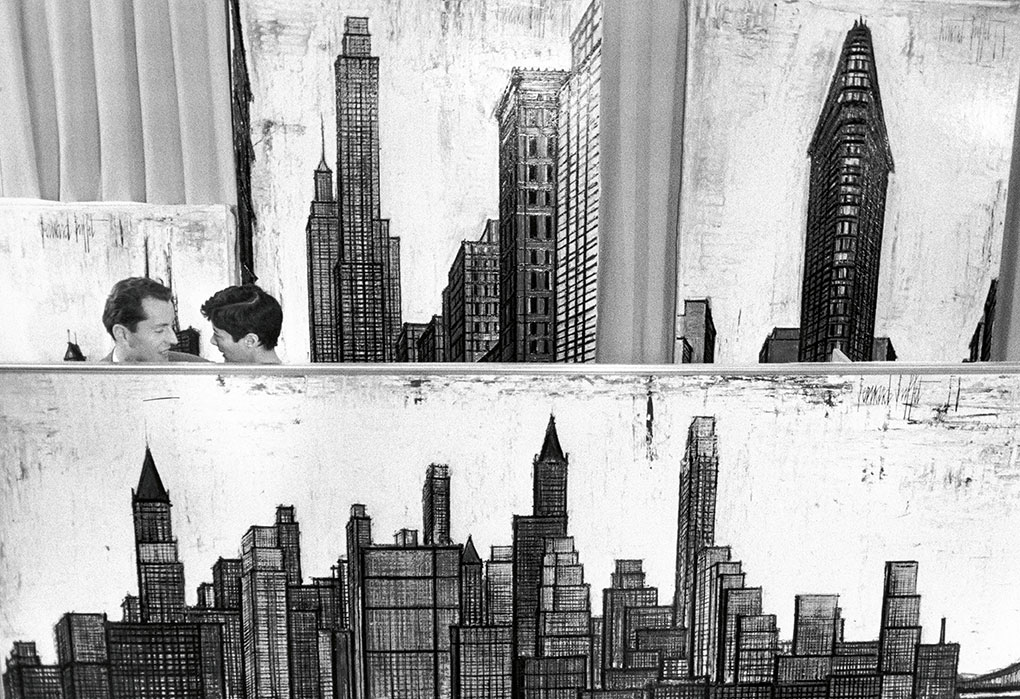
Bernard and Annabel Buffet at the Maurice Garnier gallery during the exhibition of the New York series. Paris, 1959.
© Luc Fournol
C215
C215 (Christian Guémy) is a French stencil artist, born in 1973. He shows works painted on objects in many galleries in France and around the world. C215, a great admirer of Caravaggio, wants poetry and emotion to be given space in the heart of disembodied cities: “My works place invisible people at the same level as celebrities. Through these faces, I want passers-by to be faced with their own humanity.”
In my grandmother’s house a poster of a clown, I learned later that it was created by a certain Bernard Buffet, was one of the few works of art to which I had access.
In the working class, painting was only present through reproductions, including the one that decorated the kitchen and formed a singular contrast with the tracery of the geometric motifs of the wall paper, above the large white Formica table, and was transformed into one of the few worshipped icons of my childhood.
Buffet is nostalgia. That of the sad clown, which I have also partly become, that of sincere and immediately comprehensible images, of painting that speaks, that expresses itself, and which anyone can understand. Not simplicity but the obvious. I have kept this guideline in my works. Fascination for the line too, worship of the history of art too, of the iconographic inventory to which Buffet gave himself up, so many common points that have made me want to portray him like you portray an uncle that has influenced you, who brought you beyond the linear heritage of parents who have little education, and who has taken you by the hand to discover the vastness of the history of painting. Like Andy Warhol, the Bernard Buffet of America, or like Serge Gainsbourg, another benevolent uncle, Buffet was popular, prolific. Just as I have become. He was too much, as some have criticized. Regardless of these claims, his works speak for themselves, his popularity too. He didn’t give in to the artistic imperative to be unpopular that the pedants of the salons and critical magazines brandished after the war like a flirtatious standard of the petty bourgeois to impress, to intimidate those who, from the working class believed they didn’t understand anything about art. They understood Buffet, people like Micheline my grandmother. And the sad child that I was understood him too.
“This touches me like a child to be loved by many people who are very different from each other”, he said. Words
pass by, men too, the works remain, which in the case of those by Bernard Buffet, stay alive.
C215

C215
Bernard Buffet – 2016
Stencil on wood
20.9 x 8.3 in.
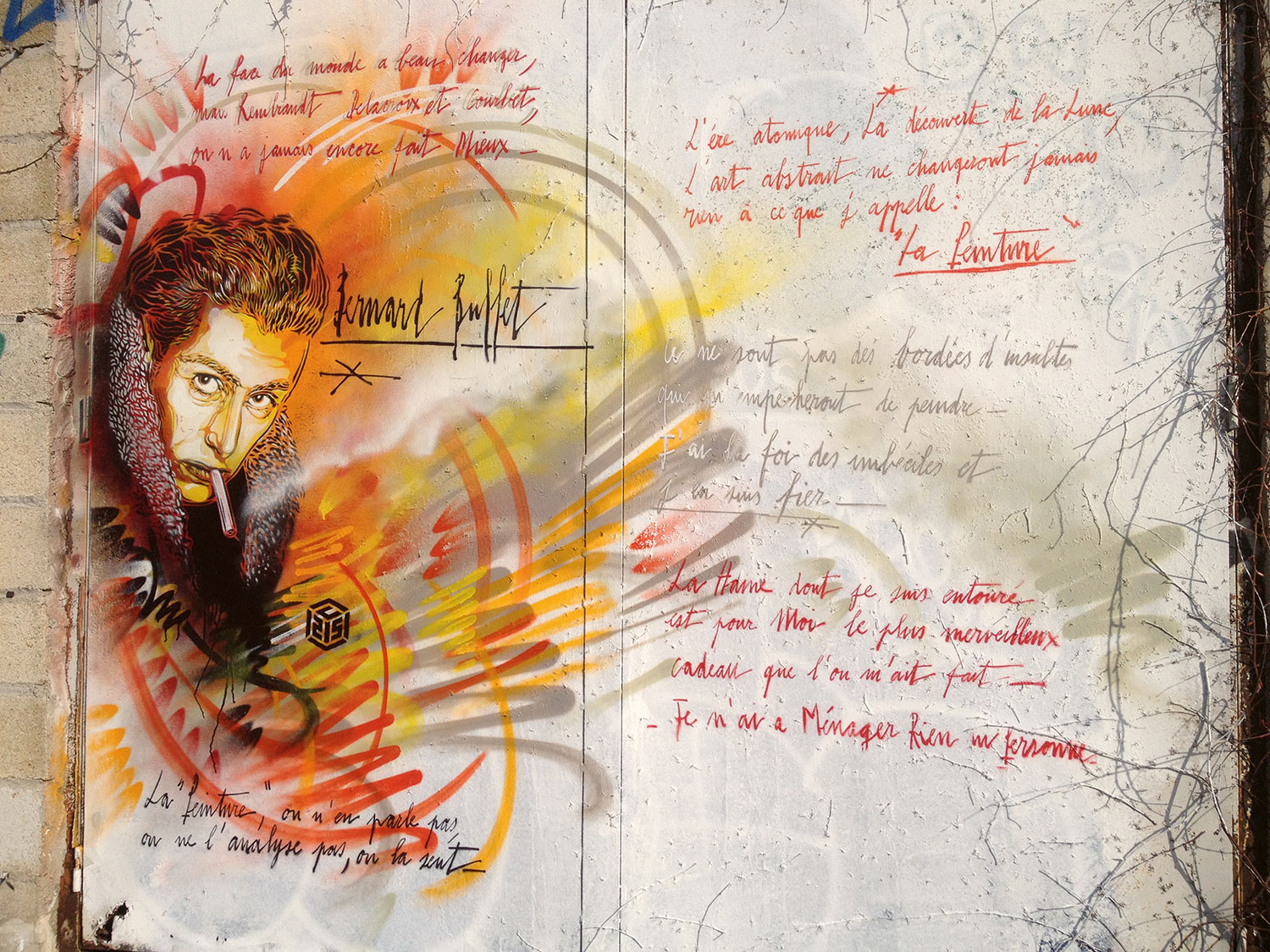
C215
Bernard Buffet – 2016
Stencil
Saint-Ouen flea market
Photo Stephane Ghez
Adrien Goudier
Adrien Goudier is a self-taught artist, born in 1985. “Self-taught in painting, free of all techniques, I’ve
always painted in the urgency of the instant, without preparing or reflecting, just by letting my emotions guide me. (…) I need to “experience” my paintings to make them. I hope they inspire you in turn!”
I was still a kid when I met Bernard Buffet through this phrase. I didn’t know anything about him yet; his name, not even his work, and even less the impact he’d have on my life…
This claim, direct and bossy, amazed me at the time and still has a strong effect now, as it’s so true and pure. But it was still nothing compared to the work of Bernard Buffet that I was going to discover. The shock was brutal and irreversible.
His style, which is so characteristic, uncompromising, urgent has instilled itself in every one of my artistic impulses.
A self-taught artist, without any formal training and often hesitating in front of a painting, this encounter liberated my gestures, made my hand more confident, more sincere too. And surely made me the “painter” that I am today. Buffet’s influence has allowed emotions to express themselves in me that I had not known, but which only needed to explode into broad daylight. And to be painted.
I rip open Bernard Buffet’s works, dissect them, and I plunge into their entrails to nourish myself with their force. Whether it’s gentle or destructive. I can’t help looking for the dark side of his most luminous paintings, and finding lightness and poetry in his blackest works. A painter of oxymorons. Painter of paradoxes. But painter of the “visible”. I’m now 35 years old and Bernard Buffet’s work, and his life, continue to thrill me, to make me dream and his shadow still hovers over me when I’m alone in front of a blank canvas.
The portrait of the “young painter of 29 rue des Batignolles” is my tribute. My wink. But above all, my own manner of saying, thank you Bernard.
Thank you for everything.
Adrien Goudier

Adrien Goudier
Le Jeune Peintre du 29 rue des Batignolles – 2019
Technique mixte sur papier / Mixed media on paper
50 x 70 cm / 19.7 x 27.5 in.
M
Matthieu Chedid (- M -) is a French musician-author-composer-performer, born in 1971. He brought out his first solo album “Le Baptême” in 1997, with which he introduced the character of – M – which he created for himself. This character can be recognized by his characteristic haircut: pointy on the sides with a curl on the forehead.
Bernard Buffet’s characteristic line crosses through consciences. The intensity of his graphic style invites itself into our modern iconography, into a spontaneous transmission. As Matthieu Chedid says when he talks about how the character of “M” came about.
“I have always been accompanied by Bernard Buffet’s painting. For my birth and also when my sister was born, our maternal grandmother gave each of us a butterfly on hardboard by Bernard Buffet. A few years later, a lithograph of the “Petit Duc” (Scops Owl) arrived in our home.
I grew up with these images before my eyes, without noticing the impact they would later have on my existence as an artist. These works have followed me all my life, finding a place wherever I have lived since.
It’s incredible to realise to what extent I was nurtured by these drawings, seeing how they influenced my visual choices! The unconscious did its work, gave me a direction that ultimately was highly familiar.
Ten years after creating the character of “M”, I realized one day, looking at the lithograph, that the visual source of my stage character derived directly from the “Petit Duc”.
But the story doesn’t stop there! With the evolution of the character M, about eight years ago, I decided to stop the haircut and to create “M glasses”. And yet again, a few years later, I understood that a secret suggestion had guided my choice. The shape of the glasses is exactly similar to the wings of Buffet’s butterflies! And if you look carefully, you find the shape of the owl’s eyes a little too.
This is not a premeditated approach: Bernard Buffet is part of the “unconscious” inspiration of my personal influences, deeply anchored. Those years spent close to the “Petit Duc” have meant that I have appropriated it for myself. It has become my totem animal.”
Mathieu Chedid

Le Petit Duc – 1984
Lithograph in 9 colours on Arches paper
Sheet 30 x 22.4 in.
Illustration 25.6 x 19.7 in.
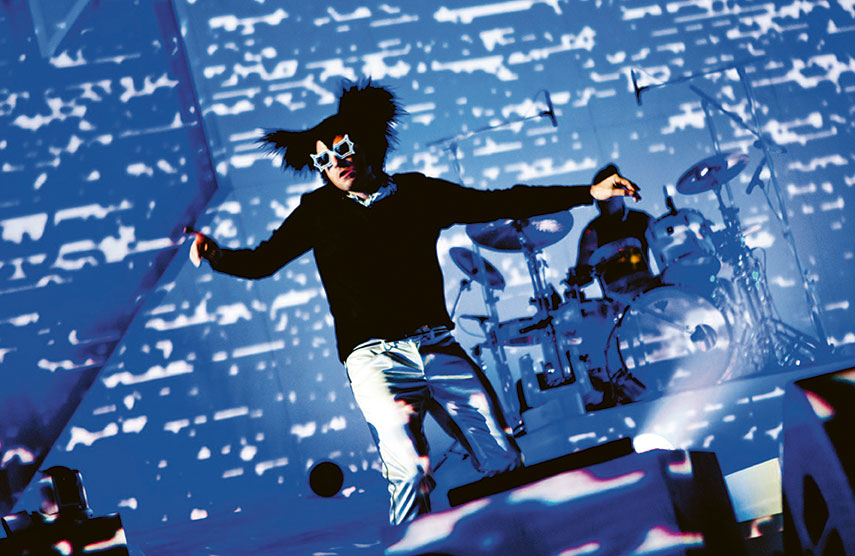
Mathieu Chedid
Photo Yann Orhan
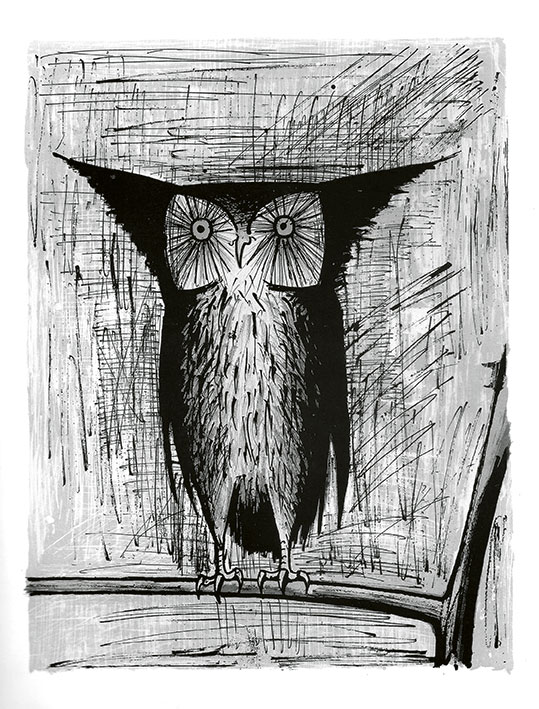
Le petit Duc – 1984
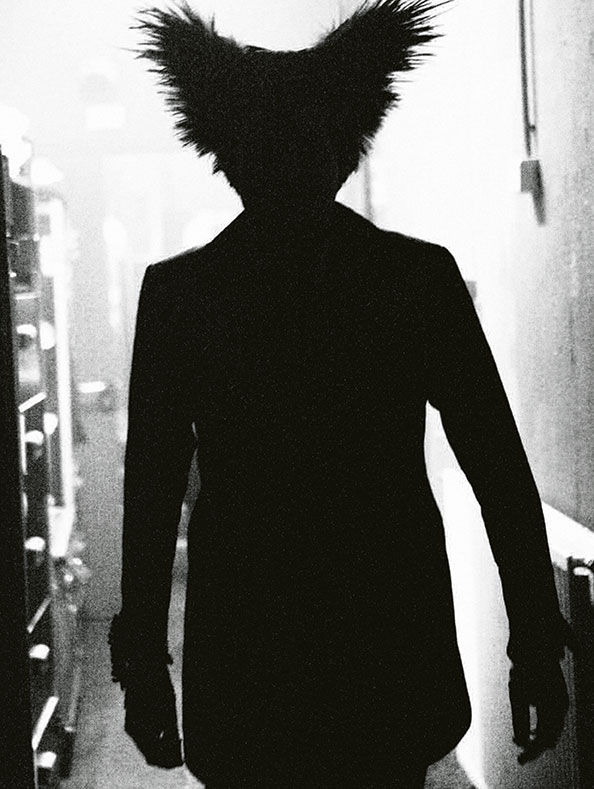
Mathieu Chedid
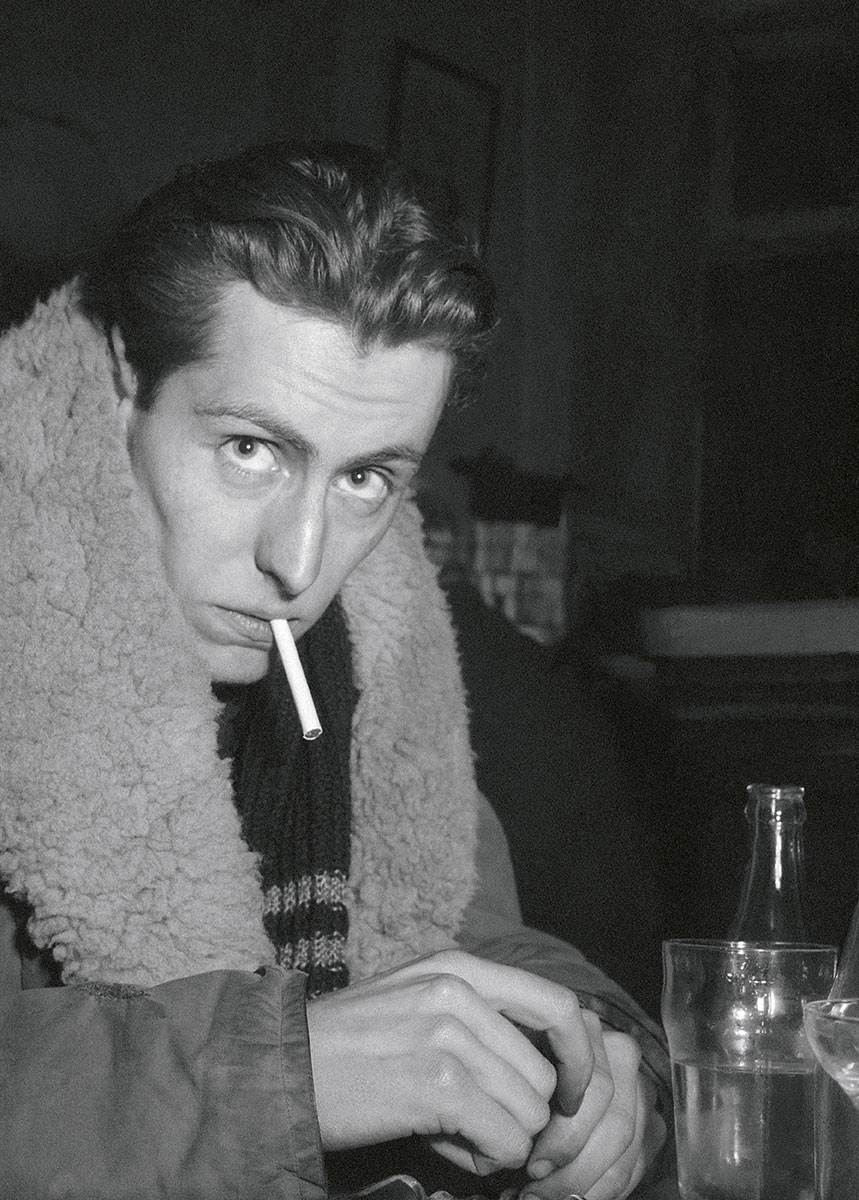
Bernard Buffet at Constant’s, rue de Seine in 1948.
© Ministère de la Culture – Médiathèque du Patrimoine, Dist. RMNGrand
Palais / Denise Colomb
Les loups de Wall Street



EXHIBITED ARTWORKS
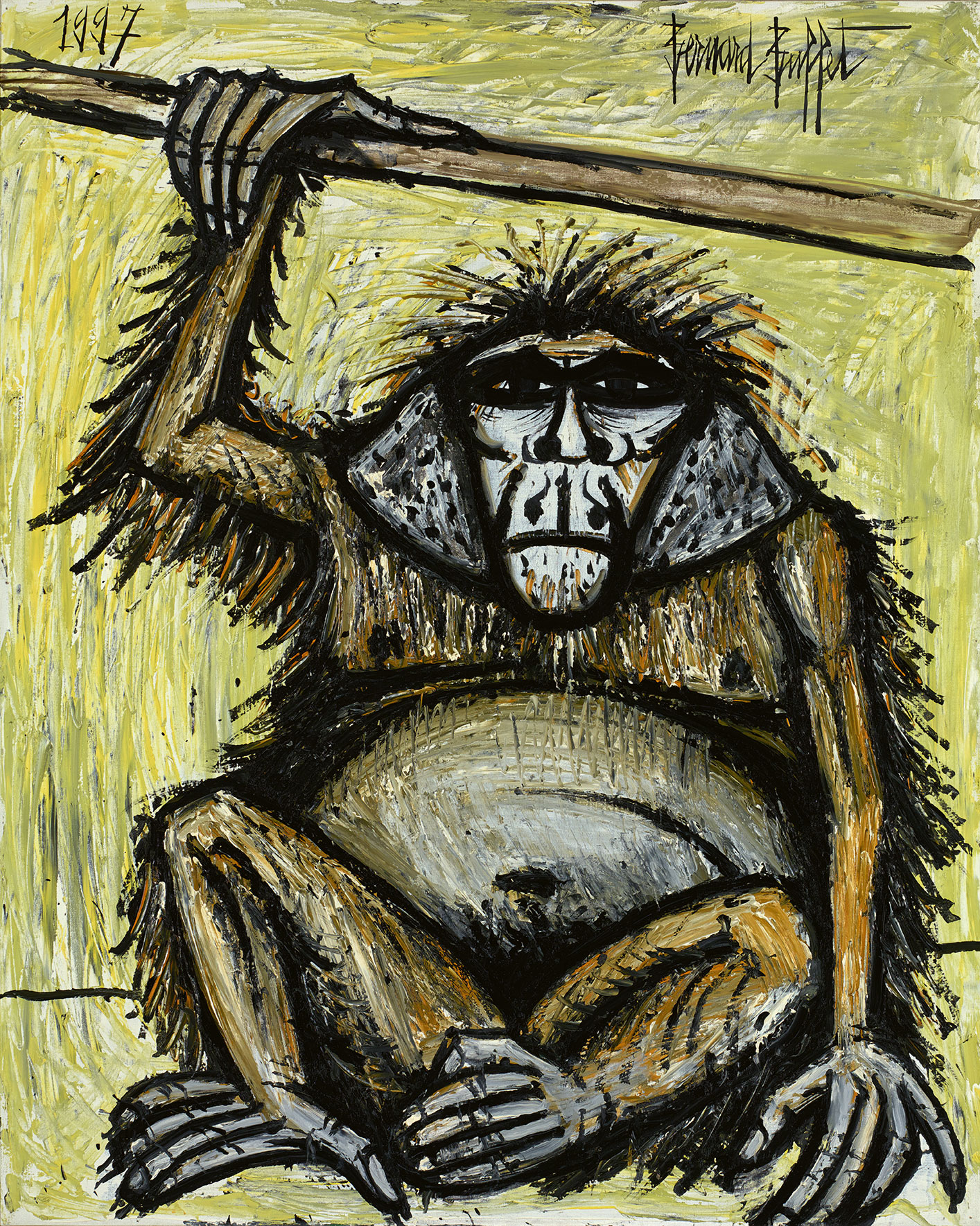
Orang Outan mâle – 1997
Oil on canvas
63.8 x 51.2 in.
Signed “Bernard Buffet” upper right and dated “1997” upper left.
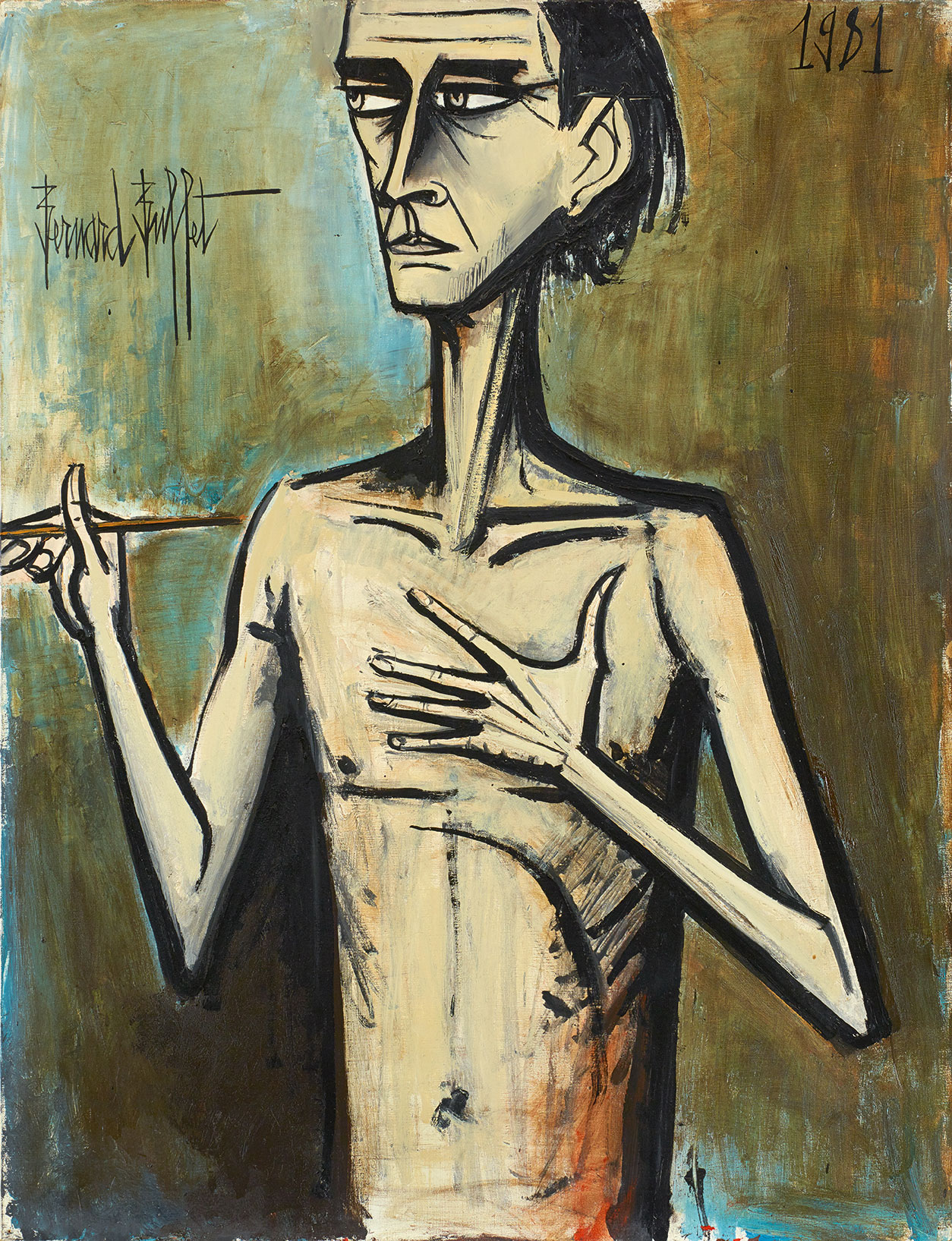
Autoportrait – 1981
Oil on canvas
45.7 x 44.9 in.
Signed “Bernard Buffet” upper left and dated “1981” upper right.
“Bernard Buffet is a genius. The word is excessive you’ll say. Dufy, before dying three years ago, said about our artist: “He is the greatest living French painter.” (…) We should say, if the word genius scandalizes you, that Bernard Buffet has a gift, a unique gift, one which is the sign of destiny. (…) The world he carries inside, he imposes it on us and forces us to see it.” Georges Hourdin, L’enfer et le ciel de Bernard Buffet, Éditions du Cerf, Paris, 1958

Libellule – 1957
Oil on canvas
30.9 x 35.8 in.
Signed and dated “Bernard Buffet 57” lower center.

Éléphant – 1997
Oil on canvas
31.9 x 45.7 in.
Dated “1997” upper left, signed “Bernard Buffet” upper right.
Titled “Elephant” on reverse.

Gibbon – 1997
Oil on canvas
31.9 x 45.7 in.
Dated “1997” upper left, signed “Bernard Buffet” upper right.
Titled “Elephant” on reverse.
“Helped by a prodigious working capacity, he became, through multiple themes, the tragic painter of man’s fate.” Maurice Druon de l’Académie française, foreword of the exhibition’s catalogue Tableaux pour un musée 1970-1976, Maurice Garnier Gallery, 2006

Hold up – 1997
Oil on canvas
31.9 x 45.7 in.
Signed “Bernard Buffet” lower left, dated “1997” lower center.
Titled “Hold-up” on reverse.

Loup – 1997
Oil on canvas
28.7 x 39.4 in.
Signed “Bernard Buffet” upper center, dated “1997” lower right.
Titled “Loup” on reverse.
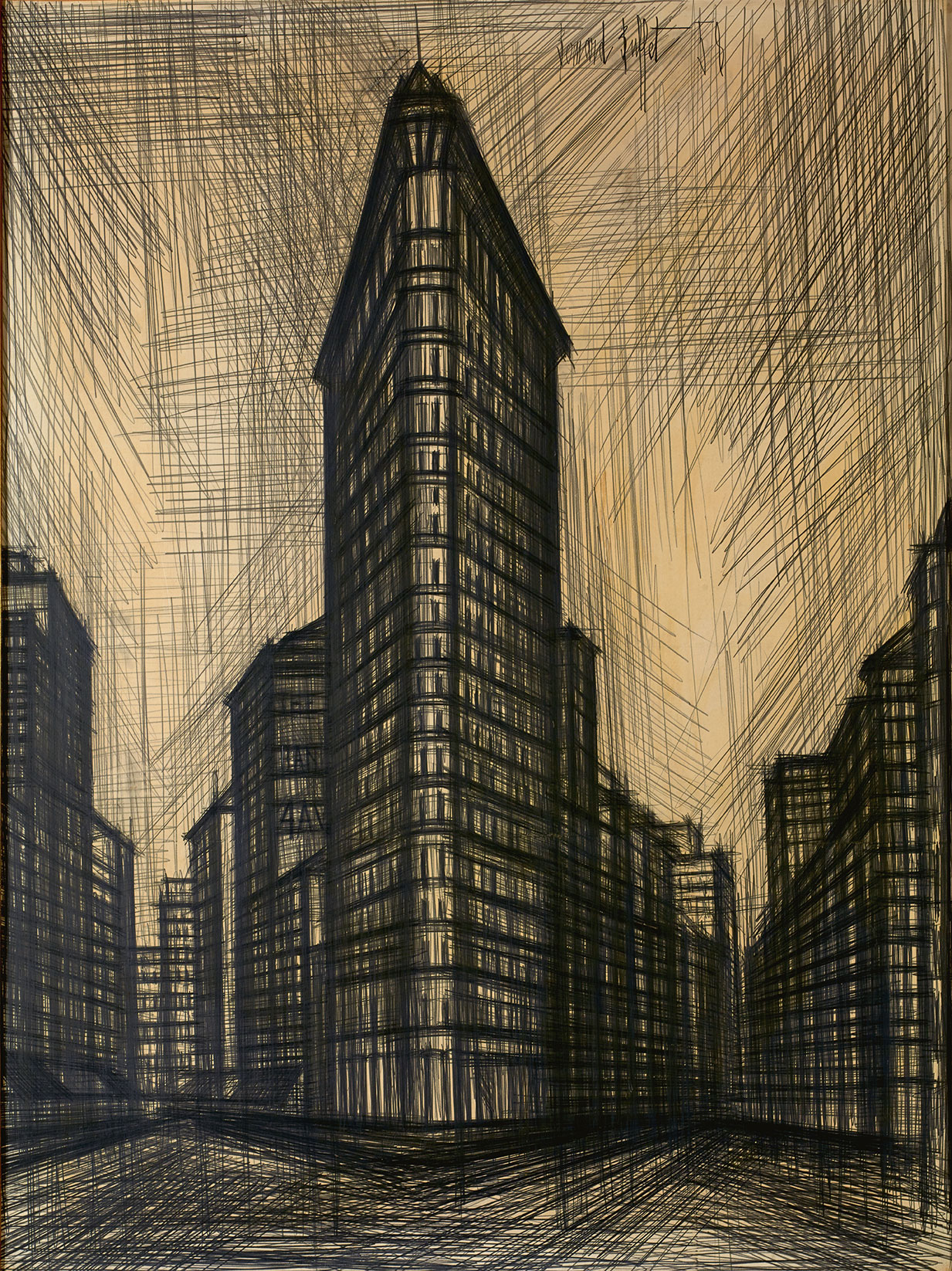
New York, Flat Iron building – 1958
Pencil on paper laid down on canvas
78.7 x 59 in.
Signed and dated “Bernard Buffet 58” upper right.
favourite artist would be the last big artist in Paris.
What’s his name?
Benjamin Buchloh: A painter?
Andy Warhol: Yes, the last famous painter. Buffet
(…)
Andy Warhol: I don’t see any difference between that and Giacometti. Somewhere along the line, people decided that it was commercial or whatever it was. (…)His work is good; his technique is really good; he’s as good as the other French guy who just died a couple of days ago, Dubuffet.”
The Duchamp Effect, Martha Buskirk et al., MIT press 1996, p. 45
Interview with Benjamin Bucholoh (1985)

New York, Daily News building – 1990
Oil on canvas – 76.8 x 44.9 in.
Signed “Bernard Buffet” upper left, dated “1990” upper right.

World Trade Center – 1989
Oil on canvas
76.8 x 44.9 in.
Dated “1989” upper left, signed “Bernard Buffet” upper right
La Méditerranée

Deux boucs – 1987
Oil on canvas
28.7 x 36.2 in.
Signed and dated “1987 Bernard Buffet” upper right.

L’entrée de Bonifacio – 1995
Oil on canvas
51.2 x 44.9 in.
Signed “Bernard Buffet” upper left, dated “1995” upper right.
Titled “L’Entrée de Bonifacio” on reverse.

La goélette Gloria – 1995
Oil on canvas
51.2 x 63.8 in.
Dated “1995” upper left, signed “Bernard Buffet” upper right.

Le Temple d’Aphaia à Egine – 1992
Oil on canvas
51.2 x 76.8 in.
Dated “1992” upper left, titled “Egine” and signed “Bernard Buffet” upper right.
Titled “Le Temple d’Aphaia Egine“ “Egine Péloponnèse”on reverse.

Rome, le Colisée – 1991
Oil on canvas
44.9 x 51.2 in.
Signed “Bernard Buffet” upper center, dated “1991” upper right.
BIOGRAPHY
1928 – Birth of Bernard Buffet on July 10th in Paris
1943 – Admitted to the Paris Ecole Nationale Supérieure des Beaux-Arts where he stayed until 1946.
1946 – Bernard Buffet exhibits for the first time at the Salon des Moins de Trente Ans [Salon for those Under Thirty], Galerie des Beaux-Arts in Paris.
1947 – Participates in the Salon des Indépendants. In December, first exhibition at the Librairie des Impressions d’Art organized by Guy Weelen and Michel Brient and presented by Pierre Descargues. The Musée National d’Art Moderne in Paris (now at the Centre Pompidou) buys for the State the painting Still Life with Chicken.
1948 – In April, Emmanuel David of the Galerie Drouant-David suggests that Bernard Buffet join the gallery with an exclusive contract. From the autumn, the exclusivity contract is shared with Maurice Garnier. In June Bernard Buffet wins the Critics Prize of the Galerie Saint-Place jointly with Bernard Lorjou.
1949 – In February, first exhibition at the Galerie Drouant-David. Marries Agnès Nanquette, a classmate from the Ecole des Beaux-Arts, he divorces her the following year.
1950 – Begins a love affair with Pierre Bergé which lasts until 1958.
1951 – Jean Giono lends Bernard Buffet a cabin in Manosque, he stays there until he moves to an old barn at Nanse where, in 1954 he paints three large works Horror of War.
1952 – Bernard Buffet illustrates the Chants de Maldor by the Comte de Lautréamont with drypoint etchings.
1953 – Bernard Buffet exhibits landscapes painted in oil at the Galerie Drouant-David and drawings on the same theme with Maurice Garnier at the Galerie Visconti. He illustrates Recherche de la Pureté by Jean Giono with drypoint prints. Louis Aragon publishes an article Le paysage a 4 siècles et Bernard Buffet 24 ans [Landscape is 4 centuries old, Bernard Buffet, 24 years old] in Lettres Françaises.
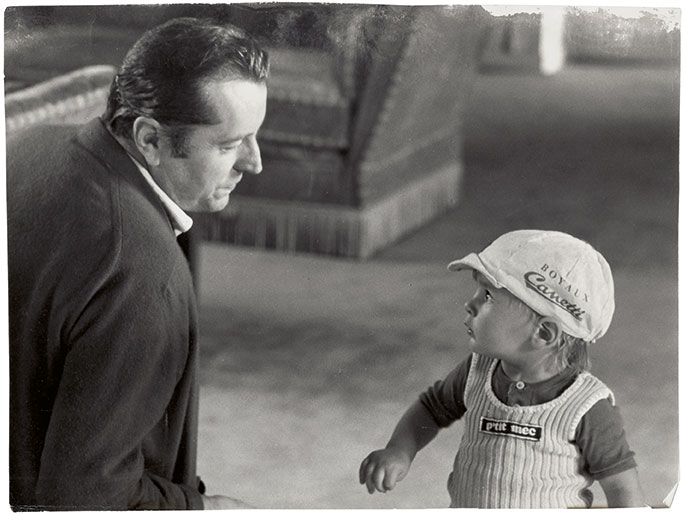
Bernard Buffet and his son Nicolas, 1973, Villiers-le-Mahieu, photograph by Annabel Buffet.
1954 – Bernard Buffet illustrates The Passion of Christ with 21 drypoint etchings.
1955 – Bernard Buffet is placed first in the referendum organized by the magazine Connaissance des Arts to designate the ten best post-war painters. He paints designs for the decors and costumes for La Chambre, lyrics by Georges Simenon, music by Georges Auric for the Ballets de Paris Roland Petit. Bernard Buffet buys the property of Manine at Domont near Paris, which he leaves the following year. He buys the Château l’Arc near Aix-en-Provence, with a view of the Montagne Saint-Victoire. It becomes his primary home until 1964.
1957 – Bernard Buffet illustrates La Voix Humaine by Jean Cocteau with drypoint prints.
1958 – First retrospective at the Galerie Charpentier in Paris. He paints the designs for the decors and costumes for Le Rendez-vous manqué, lyrics by Françoise Sagan, music by Michel Magne, choreography by John Taras and Don Lurio, directed by Roger Vadim. On 12 December in Ramatuelle, Bernard Buffet marries the singer, actress and writer Annabel Schwob.
1959 – He paints the designs for the decors and costumes of Patron, lyrics by Marcel Aymé, music by Guy Béart for the Ballets Roland Petit.
1961 – Bernard Buffet makes a group of paintings on the life of Christ to decorate the chapel of the Château l’Arc. Ten years later, following a request by Monseigneur Pasquale Macchi secretary of Pope Paul VI, Bernard Buffet donates them to the Vatican Museums.
1962 – He paints the designs for the decors and costumes for Carmen, music by Georges Bizet, directed by Louis Ducreux for the Marseille Opera. He creates an illustrated book of 16 drypoint illustrations Saint-Cast, Souvenirs d’enfance a poem by Baudelaire. He is awarded the title of Chevalier des Arts et des Lettres. His daughter Virginie is born.
1963 – Exhibitions at the Tokyo Museum of Modern Art and the Kyoto Museum of Modern Art. Birth of his daughter Danielle.
1964 – Bernard Buffet illustrates Toxique by Françoise Sagan with drawings in india ink. He buys the demesne La Vallée at Saint-Cast. Up to 1970, he divides his time between Brittany and Paris.
1965 – Bernard Buffet buys an apartment in Paris at 11, boulevard de la Tour Maubourg, he lives there until 1971.
1966 – Bernard Buffet illustrates Herbier by Louise de Vilmorin with colour lithographs.
1967 – For the Paris Opera, he paints the designs for the stage curtain, sets and costumes for Le Grand Cirque, music by Aram Khachaturian, choreography by Serge Lifar, and for the sets and costumes for Istar, music by Vincent d’Indy, choreography by Serge Lifar.
1968 – Bernard Buffet creates the publication Mon Cirque illustrated by 44 colour lithographs.
1969 – Exhibition at the Musée d’Unterlinden at Colmar.
1970 – Bernard Buffet creates the publication Jeux de Dames composed of 20 lithographs, poems by Verlaine, Rimbaud and Baudelaire.
1971 – In May, Bernard Buffet receives the award of Chevalier de la Légion d’Honneur from Maurice Druon. He buys the Château of Villiers-le-Mahieu, which he keeps until April 1978. His son Nicolas is born.
1973 – On November 25th, the Musée Bernard Buffet is inaugurated at Surugadaira in Japan, founded by Kiichiro Okano.
1974 – Bernard Buffet is elected to the Académie des Beaux-Arts on March 13th.
1975 – Bernard Buffet buys an apartment at Saint-Tropez.
1976 – Bernard Buffet illustrates Dante’s Hell with 11 drypoint prints.
1978 – Bernard Buffet is asked by the postal administration to create a design for a 3 franc stamp, the Institut and the Pont des Arts. To coincide with this the Musée Postal in Paris holds an exhibition of his work. Bernard Buffet buys a property at Saint-Tropez which he occupies only for a year.
1979 – Bernard Buffet rents an apartment at 82 boulevard de Courcelles, Paris, which he leaves the following year.
1980 – Bernard Buffet buys the Manoir de Saint-Crespin in Normandy and keeps it until April 1986.
1981 – Bernard Buffet rents an apartment at 151, avenue de Wagram, Paris to stay in while in the capital.
1986 – Bernard Buffet buys the Domaine de La Baume near Tourtour in Provence.
1989 – Bernard Buffet buys a house at 20, rue Cortot in Montmartre, Paris.
1991 – Exhibition at the Pushkin Museum, Moscow, the Hermitage in Saint-Petersbourg and at the Hyundai Museum in Seoul. The Administration du Territoire des Terres Australes et Antarctiques Françaises, asks Bernard Buffet to create a design for a stamp for 25.70 francs.
1993 – Exhibition at the Musée Gustave Courbet in Ornans. Bernard Buffet is promoted to the rank of Officier de la Légion d’Honneur.
1994 – Exhibition at the Documenta-Halle in Kassel.
1995 – Travelling exhibition in Japan (Tokyo, Kyoto, Nara, Akita, Hakodate and Obihiro).
1996 – Exhibition at the Museum of Fine Arts at Kaoshiung, Taiwan.
1999 – Exhibition at the National Gallery of Erevan, Armenia. Bernard Buffet, suffering from Parkinson’s Disease and no long able to paint, commits suicide on 4 October.
2000 – In February, his final thematic exhibition opens at the Galerie Maurice Garnier with the title La Mort.

Catalogue of the exhibition New-York by Bernard Buffet, David B. Fondlay Gallery, New York, 1959
FIRST EXHIBITIONS
1946-1947 Salon des Moins de Trente Ans, Galerie des Beaux-Arts, Paris
1947 Galerie des impressions d’Art, Paris
1947-1955, 1967, 1969, 1971,1978-1988 Salon des Tuileries, Galerie Charpentier, Paris
1947, 1948 Salon des Indépendants, Paris
1948 Salon d’Automne, Paris
1948 “Prix de la Jeune Peinture”, Galerie Drouant-David, Paris
1948 “Prix de la Critique”, Galerie Saint-Placide, Paris
1948 Salon de Mai, Paris
1949 “Second Manifeste de l’Homme témoin”, Galerie Claude, Paris
1950-1952 Salon des Jeunes Peintres, Galerie des Beaux-Arts, Paris
1952 Biennale de Venise, pavillon français, Venice
1956 Biennale de Venise, pavillon français (salle particulière), Venice
1962-1971 Salon des “Peintres témoins de leur temps”, Musée Galliera, Paris
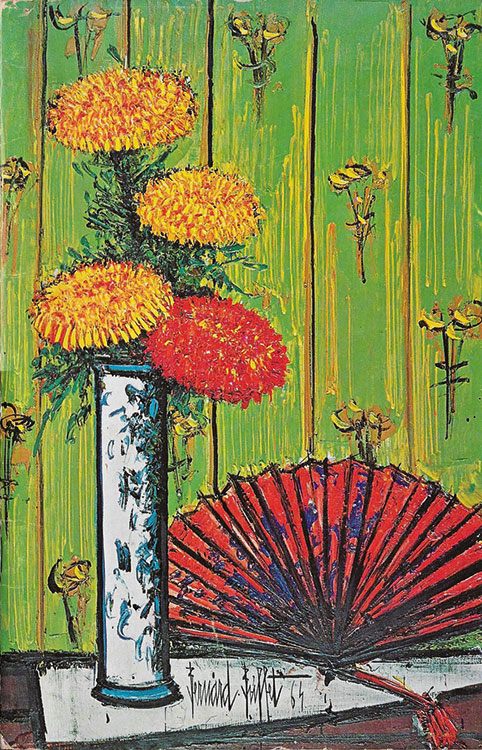
Poster of the exhibition Fleurs et Paysages par Bernard Buffet, Wally Findlay Galleries, 1964
ANNUAL EXHIBITIONS
Galerie Drouant-David
1949-1951 Solo show
1952 La Passion du Christ
1953 Paysages
1954 Nus
1955 Horreur de la Guerre
1956 Le Cirque
Galerie Visconti
1952 La Passion du Christ (drawings)
1953 Paysages (drawings)
1954 Bestiaire (drawings)
1955 Horreur de la Guerre (watercolours)
1956 Le Cirque (watercolours)
Galerie David et Garnier
1957 Paysages de Paris
1958 Jeanne d’Arc
1959 New York
1960 Les Oiseaux
1961 Portraits d’Annabel
1962 La Chapelle de Château l’Arc
1963 Paysages de Venise
1964 Le Muséum de Bernard Buffet
1965 Les Écorchés then Vingt tableaux peints à Saint-Cast
1966 Femmes déshabillées
1967 La Corrida
Galerie Maurice Garnier
1968 Les Plages
1969 Églises de France then Paysage de Bretagne
1970 Châteaux de la Loire
1971 Les Folles
1972 Danièle et Virginie
1973 Les Bateaux
1974, 1975 Paysages
1976 Paysages de neige
1977 L’Enfer de Dante then Natures mortes
1978 La Révolution française puis Aquarelles de Saint-Tropez
1979 Fleurs puis Aquarelles de Saint-Tropez
1980 Nus
1981 Le Japon then Les Oiseaux d’Hokkaido
1982 Autoportraits
1983 Paysages
1984 Petits formats
1985 L’Automobile
1986 Les Pays-Bas
1987 Vues de Venise (watercolours)
1988 Sumo et Kabuki then Natures mortes
1989 Don Quichotte
1990 Vingt mille lieues sous les mers then La Bretagne
1991 Vues de New York then Souvenirs d’Italie
1992 Les Clowns Musiciens then Saint-Pétersbourg
1993 L’Empire ou les Plaisirs de la Guerre then Promenade
Provençale
1994 L’Odyssée
1995 Les Sept Péchés Capitaux
1996 Pékin then Gravures à la pointe-sèche
1997 Régates
1998 La Maison
1999 Mes Singes
2000 La Mort
2001 Tableaux pour un musée (theme taken up each
year until 2009)
MAIN RETROSPECTIVES AND PERSONAL EXHIBITIONS
1955 Bernard Buffet, Galerie Lucien Blanc, Aix-en-Provence
1955 Paintings by Bernard Buffet, Los Angeles County Museum
1957 Niveau Gallery, New York
1958 Cent tableaux de 1944 à 1958 par Bernard Buffet, Galerie Charpentier, Paris
1958 Les Voyages fantastiques de Cyrano de Bergerac, Musée Jacquemart-André, Paris
1958 Bernard Buffet, Institut français, Berlin
1963 Bernard Buffet, National museum of modern art of Tokyo, National Museum of modern art of Kyoto
1968 Bernard Buffet, Radierungen, Städtische Kunsthalle, Mannheim
1969 Bernard Buffet, Musée Unterlinden, Colmar
1978 Sapporo Hokkaido Museum of Modern Art
1978 Bernard Buffet, Musée postal, Paris
1980 Itinerant retrospective of the lithographed work in Japan
1991 Pouchkine museum, Moscow ; Ermitage museum, St Petersburg.
1993 Bonjour Monsieur Buffet !, Musée Gustave Courbet, Ornans
1993 Vingt mille lieues sous les mers, Musée départemental de l’Oise, Beauvais
1993 Bernard Buffet, Château de Chenonceau
1994 Bernard Buffet retrospektive, Documenta-Halle, Kassel
1995 Bernard Buffet, Odakyu Museum of Art, Tokyo ; Takashimaya Museum of art, Kyoto ; Nara Sogo Museum, Nara ; Akita Senshu City Museum, Akita ; Hakodate Public Museum, Hokkaido ; Obihiro, Public Museum, Hokkaido
1997 Jeanne d’Arc, Palais de Justice, Rouen
1998 Bernard Buffet, Palais Bénédictine, Fécamp
2000 Sogo museum, Yokohama
2003 Bernard Buffet, Musée Paul Valéry, Sète
2006 Bernard Buffet: een omstreden oeuvre, Gemeentemuseum, La Haye
2007 Bernard Buffet et la Bretagne, Musée département breton, Quimper
2008 Bernard Buffet Maler, MMK Museum für Moderne Kunst, Frankfurt am Main
2009 Bernard Buffet, Centre de la Vieille Charité, Marseille
2009 Bernard Buffet et Annabel, Sogo Museum of Art in Yokohama
2010 Bernard Buffet, Meguro Museum, Tokyo
2014 Post 1958 : une symphonie de couleur en plus, Musée du Touquet-Paris-Plage, Le Touquet
2014 Salle d’exposition du Gouvernement, Andorre
2014-2015 Bernard Buffet, Heydar Aliyev Center, Bakou
2016-2017 Bernard Buffet Rétrospective, Musée d’art moderne de la Ville de Paris, Paris
2016-2017 Bernard Buffet, Intimement, Musée de Montmartre, Paris
2017 1948-1956 Roger Dutilleul, l’oeil d’un collectionneur, Galerie Diane de Polignac, Paris
2019 Bernard Buffet, Rétrospective, Seoul Arts Center, Seoul
2022 Bernard Buffet Aujourd’hui, Galerie Diane de Polignac, Paris

Poster for the 15th Rallye de la Vallée des Gaves, illustrated by Bernard Buffet, 1970
MAIN GROUP EXHIBITIONS
1952 Recent Trends in Realist Painting, Institute of Contemporary Arts, London
1953 Bernard Buffet, Bernard Lorjou, Louis Valtat, Claude Venard, Musée de L’Athénée, Geneva
1957 Bernard Buffet, Kunstverein, Munich
1959 Modern Art Museum, Kanagawa
1960 Musée de L’Athénée, Geneva
1970 Petit Palais de Genève, Geneva
1973 Musée du Vatican, Rome
1973 Grand Palais, Paris
1985 L’Automobile, Musée de l’Automobile, Mulhouse
1995 Galerie nationale d’art moderne, Tbilissi
1995 Centre Jean Giono, Manosque
1999 Galerie nationale d’Arménie, Erevan
2002-2003 Paris, capitale des arts, 1900-1968, Royal Academy of Art, London ; Guggenheim Museum, Bilbao
2002-2003 Cher peintre…, Lieber Maler…, Dear Painter…, Centre Pompidou, Paris ; Kunsthalle, Vienna ; Schirn Kunsthalle, Frankfurt am Main
2003 Coollustre, collection Lambert, Avignon
2004 Moi – Autoportraits du XXe siècle, Musée du Luxembourg, Paris
2005 Une histoire de paravents, La Piscine, Roubaix
2006 La Force de l’Art, Grand Palais, Paris
2007 Année 1950, l’alternative figurative, Musée d’Art Roger-Quillot, Clermont-Ferrand
2007 Pont-Aven, du paysage à l’oeuvre, Musée de Pont-Aven
2009 Galerie Rodolphe Janssen, FIAC, Paris
2010 C’est la vie – Vanités du XVe au XXe siècle, Musée Maillol, Paris
2010 Aragon et l’Art moderne, Musée de la Poste, Paris
2010 De Nolde à Buffet, Forum Würth, Arlesheim
2011 Oceanomania, Nouveau Musée national de Monaco, Villa Paloma
2012-2013 L’Art en guerre, France 1938-1947, Musée d’art moderne de la Ville de Paris ; Guggenheim Museum, Bilbao

Stamp of the Republic of Guinea with the effigy of Bernard Buffet, 2009
SELECTIVE BIBLIOGRAPHY
Pierre DESCARGUES, Bernard Buffet, Éditions P.L.F., Paris, 1949
Pierre DESCARGUES, Bernard Buffet, Éditions P.L.F., Paris, 1952
Pierre BERGÉ, Bernard Buffet, Horreur de la guerre, Éditions Parenthèses, Paris, 1955
Jean GIONO, Bernard Buffet, Éditions Fernand Hazan, Paris, 1956
Pierre BERGÉ, Bernard Buffet, Éditions l’Artisan, Paris, 1958
Pierre BERGÉ, Bernard Buffet, Éditions Pierre Cailler, Genève, 1958
Georges SIMENON et Jean BOURET, Bernard Buffet, Éditions Les Cahiers de la Peinture, Paris,1958
Georges HOURDIN, Bernard Buffet, Éditions du Cerf, Paris, 1958
Pierre BERGÉ, Bernard Buffet, Art et Style, Paris, 1958
Maurice DRUON, Bernard Buffet, Éditions Hachette, Paris, 1964
Pierre CABANNE, Bernard Buffet par, Éditions Fernand Hazan, Paris, 1966
Charles SORLIER, Bernard Buffet lithographe I, Éditions Michèle Trinckvel, Paris, 1979
Maurice RHEIMS, Bernard Buffet graveur, Éditions d’Art de Francony, Éditions Maurice Garnier,1983
Uwe BRAUER, Bernard Buffet, biographie, Éditions Pro Art, Geneva, 1983
Annabel BUFFET, D’amour et d’eau fraîche, Éditions Sylvie Messinger, Paris, 1986
Yann LE PICHON, Bernard Buffet, (deux premiers volumes de la monographie), Éditions Galerie Maurice Garner, Paris, 1986
Georges DURAND, La divine comédie de Bernard Buffet, Éditions Desclée de Brouwer, Paris, 1986
Charles SORLIER, Bernard Buffet lithographe II, Paris, Éditions André Sauret, Monte-Carlo, 1987
Alin Alexis AVILA, Bernard Buffet, Éditions Casterman, Paris, 1989
Stéphane LAURENT, Bernard Buffet, le peintre crucifié, biographie, Éditions Michalon, Paris, 2000
Annabel BUFFET, Post Scriptum, Éditions Plon, Paris, 2001
Annabel BUFFET et Jean-Claude LAMY, Bernard Buffet, secrets d’atelier, textes, photographies de Luc Fournol et Benjamin Auger, Éditions Flammarion, Paris, 2004
Lydia HARAMBOURG, Bernard Buffet et la Bretagne, Éditions Palantines, Quimper, 2006
Henry PÉRIER, Bernard Buffet et la Provence, Éditions Palantines, Quimper, 2007
Brigitte CAMUS, Buffet ou la psychanalyse en signature, Éditions de l’Épure, 2007
Yann LE PICHON, Bernard Buffet (troisième volume de la monographie), Éditions Galerie Maurice Garnier, Paris, 2007
Jean-Claude LAMY, Bernard Buffet, le Samouraï, Biographie, Éditions Albin Michel, Paris, 2008
John SILLEVIS, Bernard Buffet, monographie, Éditions Palantines, Quimper, 2008
Lydia HARAMBOURG, Bernard Buffet, Fonds de dotation Bernard Buffet, Éditions Palantines, Quimper, 2013
Picasso, Léger, Masson. Daniel-Henry Kahnweiler et ses peintres, LAM, SNEL Graphics, Vottel (Herstal), Belgium, 2013
Nicholas FOULKES, Bernard Buffet: The Invention of the Modern Mega-artist, Preface publishing, London, 2016 Bernard Buffet, catalogue de l’exposition au Musée d’art moderne de la Ville de Paris du 14 octobre 2016 au 26 février 2017, Éditions Paris Musées, Paris, 2016
Bernard Buffet, Intimement, catalogue de l’exposition au Musée de Montmartre-Jardins Renoir du 18 octobre 2016 au 5 mars 2017, Somogy éditions d’art, Paris, 2016
Catalogue Raisonné de l’OEuvre peint de Bernard Buffet de 1941 à 1953, Fonds de Dotation Bernard Buffet, Paris, 2020
Diane de Polignac Gallery particularly thanks Mr. Jany Jansem for making this beautiful project of exhibition and publication possible.
Diane de Polignac Gallery warmly thanks Mr. Nicolas Buffet for his collaboration and knowledge of his father’s work which have been essential assets for this project success.
Many thanks again to all the participants for their precious testimonies: Mr. Matthieu Chedid, Mr. Adrien Goudier, M. Christian Guemy, and to Mr. Gaspard Borgeaud, Mr. Cyril Clément, Mr. Christophe Mabillon and Mrs. Audrey Roué for their collaboration.
Bernard Buffet Aujourd’hui
Exhibition from May 12 to June 4, 2022
Diane de Polignac Gallery
2 bis, rue de Gribeauval, Paris
www.dianedepolignac.com
Production: Jany Jansem
Translation: Jane Mac Avock
Graphic design: Christian Demare
ISBN: 978-2-9548416-9-4
© Diane de Polignac Gallery, Paris, April 2022
Texts are author’s property: © Nicolas Buffet, © Matthieu Chedid,
© Adrien Goudier, ©Christian Guemy
© ADAGP, Paris 2022 for the works of Bernard Buffet
Reserved rights
